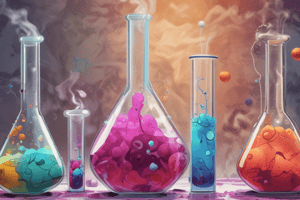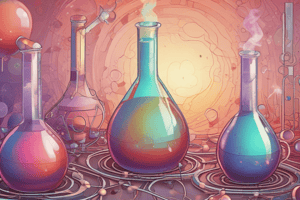Podcast
Questions and Answers
What is the term for the substances that undergo a chemical change in a reaction?
What is the term for the substances that undergo a chemical change in a reaction?
- Intermediates
- Products
- Reactants (correct)
- Catalysts
What type of reaction involves the combination of two or more reactants to form a single product?
What type of reaction involves the combination of two or more reactants to form a single product?
- Single displacement reaction
- Synthesis reaction (correct)
- Decomposition reaction
- Double displacement reaction
What is the purpose of adding coefficients to a chemical equation?
What is the purpose of adding coefficients to a chemical equation?
- To balance the equation (correct)
- To indicate the reaction mechanism
- To identify the catalysts
- To indicate the physical state of the reactants
What is the term for the study of the quantitative relationships between reactants and products in a chemical reaction?
What is the term for the study of the quantitative relationships between reactants and products in a chemical reaction?
What is the purpose of balancing a chemical equation?
What is the purpose of balancing a chemical equation?
What is the ratio of moles of one substance to moles of another substance in a reaction?
What is the ratio of moles of one substance to moles of another substance in a reaction?
Which type of reaction involves the exchange of partners between two compounds, resulting in two new compounds?
Which type of reaction involves the exchange of partners between two compounds, resulting in two new compounds?
What is represented by the numbers in front of formulas in a balanced equation?
What is represented by the numbers in front of formulas in a balanced equation?
Flashcards are hidden until you start studying
Study Notes
Chemical Reactions
- A chemical reaction is a process in which one or more substances are converted into new substances
- Reactants: substances that undergo a chemical change
- Products: substances formed as a result of a chemical change
Types of Chemical Reactions
- Synthesis reaction: two or more reactants combine to form a single product
- Example: 2H2 + O2 → 2H2O
- Decomposition reaction: a single reactant breaks down into two or more products
- Example: 2H2O → 2H2 + O2
- Single displacement reaction: one element displaces another element from a compound
- Example: Zn + CuSO4 → ZnSO4 + Cu
- Double displacement reaction: two compounds exchange partners, resulting in two new compounds
- Example: NaCl + AgNO3 → NaNO3 + AgCl
Chemical Equations
- A chemical equation is a symbolic representation of a chemical reaction
- Equations must be balanced, meaning the number of atoms of each element is the same on both the reactant and product sides
Balancing Chemical Equations
- Steps to balance an equation:
- Write the unbalanced equation
- Count the atoms of each element on both sides
- Add coefficients (numbers in front of formulas) to balance the equation
- Check the equation to ensure it is balanced
Examples of Balanced Equations
- 2H2 + O2 → 2H2O
- Ca + O2 → 2CaO
- NaOH + HCl → NaCl + H2O
Stoichiometry
- Stoichiometry is the study of the quantitative relationships between reactants and products in a chemical reaction
- Mole ratios: the ratio of moles of one substance to moles of another substance in a reaction
- Stoichiometric coefficients: the numbers in front of formulas in a balanced equation, which represent the mole ratios
Chemical Reactions
- Chemical reactions involve the conversion of one or more substances into new substances
- Reactants undergo a chemical change, resulting in products
Types of Chemical Reactions
- Synthesis reactions: two or more reactants combine to form a single product
- Decomposition reactions: a single reactant breaks down into two or more products
- Single displacement reactions: one element displaces another element from a compound
- Double displacement reactions: two compounds exchange partners, resulting in two new compounds
Chemical Equations
- Chemical equations represent chemical reactions symbolically
- Equations must be balanced to ensure the number of atoms of each element is the same on both reactant and product sides
Balancing Chemical Equations
- Steps to balance an equation:
- Write the unbalanced equation
- Count the atoms of each element on both sides
- Add coefficients to balance the equation
- Check the equation to ensure it is balanced
Characteristics of Balanced Equations
- The number of atoms of each element is the same on both reactant and product sides
- Coefficients are used to balance the equation
Stoichiometry
- Stoichiometry studies the quantitative relationships between reactants and products in a chemical reaction
- Mole ratios: the ratio of moles of one substance to moles of another substance in a reaction
- Stoichiometric coefficients: the numbers in front of formulas in a balanced equation, representing mole ratios
Studying That Suits You
Use AI to generate personalized quizzes and flashcards to suit your learning preferences.




